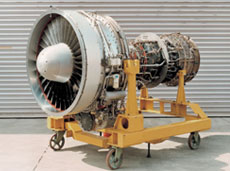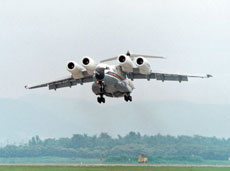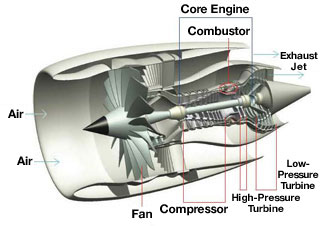


FJR710 Fan Jet Engine

Asuka - experimental quiet STOL aircraft
Q. What is the mandate of the Aviation Program Group?
We research and develop key advanced technologies to help Japan's aviation industry in the production of domestic passenger aircraft. These include environmentally compatible engines, next-generation supersonic aircraft, safe flight control, and unmanned aircraft for meteorological or disaster monitoring. In other words, our mission is to conduct basic research on promising new technologies, and to pass the results on to Japan's private sector.
We also maintain Japan's only large-scale test facilities, which we share with the private sector, since the resources required for such facilities make it almost impossible for a single company to operate them on its own. Additionally, we have expertise in design and analysis technology such as computational fluid dynamics. We work closely with the private sector throughout to design software for use in that sector.
Our achievements in such public-private partnerships, where we have developed a core technology and passed it on to the private sector, include the FJR710 Fan Jet Engine and the introduction of carbon fiber composite into aircraft manufacturing. Development of the FJR710 started in 1971 at the National Aerospace Laboratory of Japan (now part of JAXA), and the technology was recognized worldwide as cutting-edge. Subsequently, the FJR710 technology was adapted for the V2500 engine, co-developed by the United States, Britain, Germany, Italy and Japan. The V2500 has been installed on many fuselages, including Airbus and Boeing aircraft, and more than 70 airlines are using the engine today. Japan's aviation industry was once left behind by the rest of the world, being completely banned from developing and manufacturing any aircraft in the postwar era. Considering that fact, you could say that the V2500 engine is a first in Japan's modern aviation industry.
The Japan Society of Mechanical Engineers established the Mechanical Engineering Heritage certification in honor of its 110th anniversary, and awarded the certification to the FJR710, the precursor of the V2500.
Today we are also on the leading edge of carbon fiber technology. Carbon fiber is a material that's both light and strong, and is used in a variety of products, such as sporting goods. The aircraft Asuka, with a tail unit made of carbon fiber composite, successfully completed its first flight in 1985, but unfortunately, Asuka was not a commercial success. Since then, however, the technology for incorporating carbon fiber composite into airframe has vastly improved, and today the material is being used in a brand-new aircraft, the Boeing 787, scheduled for its first flight in 2008. The primary component of the fuselage and all wings is carbon fiber composite (carbon fiber reinforced plastic) rather than the conventional aluminum alloy. The main wings are manufactured by a Japanese company, Mitsubishi Heavy Industries. It is the first time that Boeing has entrusted the production of the main wings to an external enterprise. Thanks to this, sales in Japan's aviation industry are rapidly increasing. This is a good example of the kind of success in basic research that we strive for.
Q. What is the significance of JAXA developing aviation technology?
The purpose is to help strengthen the Japanese aviation industry by developing advanced technologies under national leadership. When a new technology is proven successful, new areas of opportunity open up. And once its potential is recognized outside Japan, we can take a leadership role in collaborating with other nations in developing practical applications. In the aircraft field, though, it is not enough to just develop and test new technology. This is a pointless exercise unless it is commercialized and the general public benefits from it. And since the size of the Japanese market is limited, the technology must be applied to a product that's strongly competitive in the global market. So our ultimate goal is to develop technologies that will be used for passenger aircraft around the world.

Clean engine (conceptual rendering)
A clean engine is an environmentally friendly engine, which is key to the reduction of harmful gas emissions, noise and fuel consumption. In other words, the engine is quiet, and emits much less carbon dioxide and toxic nitrogen oxide (NOx). And it can also fly aircraft for longer periods and greater distances with less fuel.
Q. What was the motivation behind the development of clean engine technology?
The world is threatened by global warming, which is caused by human activity. So our motivation is to address this serious environmental problem. Our role is to build the fundamental technology, so that the private sector can use it to design and manufacture new, cleaner engines. Until now, the focus of aviation technology had always been on fulfilling our desire to travel faster and farther, without much thought given to the environmental effects. But today we can no longer ignore the air pollution problem caused by emissions from aircraft engines. The quality of our lives is at risk if we do not take immediate action to stop global warming. So developing technology to mitigate environmental damage is obviously very important for the survival of our species.
The International Civil Aviation Organization (ICAO) sets standards on noise pollution and harmful emissions for the international civil-aviation industry. Its requirements are becoming tighter each year, so we must anticipate future regulations and develop engines with lower emissions than the current standards require.
In response to such global demand, the New Energy and Industrial Technology Development Organization (NEDO) launched the Research and Development of Environmentally Compatible Engines for Small Aircraft project (the Eco Engine Project) in 2003. The goal of the project, which is subsidized by the Ministry of Economy, Trade and Industry, is to produce environmentally friendly, low-cost Japanese engines for next-generation passenger aircraft. JAXA is a partner on the technical side.
Q. What is the roadmap for the practical application of clean engines?
Clean-engine development started in 2003, and the core technology was developed from 2004 to 2006. The core technology is a cooling mechanism for the turbines and combustor, which plays a key role in reducing emissions of harmful substances. Over the next few years, we are scheduled to conduct extensive trials of the technology using test engines. And by 2011, we expect to build a clean engine with new technologies developed by JAXA, and to test its performance. This roadmap has been designed to align with each development phase of NEDO's Eco Engine Project.